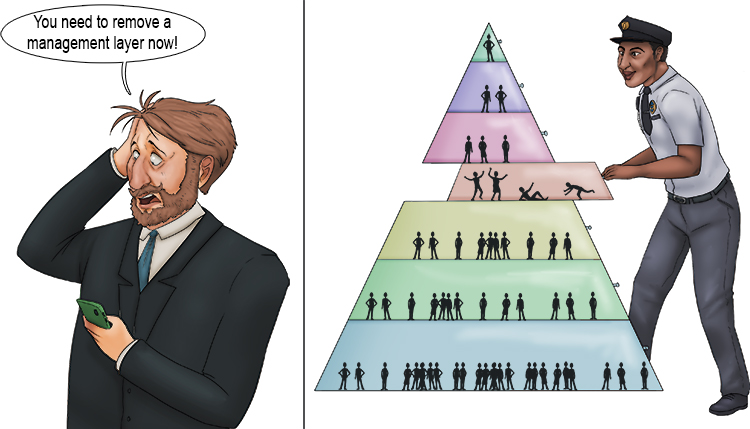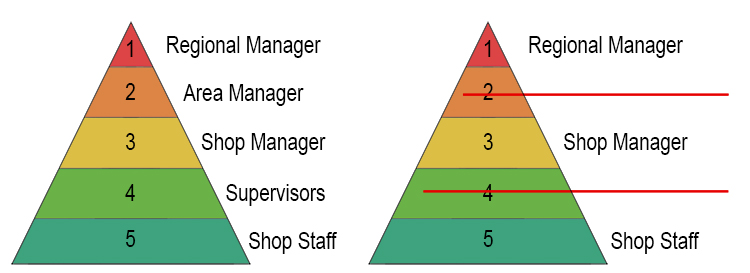Delayering – The reorganisation of an organisation's employees so that there are fewer levels of management
(Pronounced dee-lay-uh-ring)
To remember what delayering means use the following mnemonic:
Don't delay in removing layers of people. Ring (delayering) the security guard to remove layers of management.


If a company has too many layers in their hierarchy, it can make it less efficient, with communication difficult and decision-making slow. If it is possible to remove management layers without seeing a drop in productivity, it can save the company a significant amount in wages while also making the company more dynamic and less rigid.
An example of a company successfully delayering is General Electric. In the early 2000s, the multinational conglomerate GE was struggling financially. The company was too complex and bureaucratic, and it was slow to make decisions. In 2001, the CEO began a process of delayering to improve this. Layers of management were removed and employees were given more autonomy. This allowed GE to be nimbler and more responsive to changes in the market because decisions could be made much more quickly with the flatter organisational structure. As a result of this, GE was able to improve its financial performance and become one of the most successful companies in the world.
Another example of a company successfully delayering is Netflix. Netflix has embraced a very flat organisational structure, which has contributed to its growth. Instead of having many layers of management, they created ‘teams of equals’ and cross-functional teams from different departments who are able to disperse information quicker and work more effectively together. Management oversight is limited and employees work equally on projects.
However, not all examples of delayering result in positive outcomes. An example of a delayering strategy backfiring is the American department store chain Sears. Sears was a former retail giant that once dominated the market, but by the early 2000s, they were struggling in a rapidly changing business environment. Sears began delayering in an attempt to become more efficient. Many layers of management were removed and employees were allowed to be more independent. However, this strategy failed, as without the support of middle management, employees were not able to make decisions quickly enough to compete with online retailers such as Amazon. Additionally, the new decentralised structure made it difficult to coordinate its marketing and operations, and as a result, the company lost customers and revenue, eventually leading to bankruptcy.
The same mistakes made by Sears were also made by the struggling former camera giant Kodak before filing for bankruptcy in 2012. This can be seen in a trend of formerly large businesses trying to rapidly solve their failing performance through hasty and ill-thought attempts to delayer, but without the necessary skills or organizational culture to pull it off.




